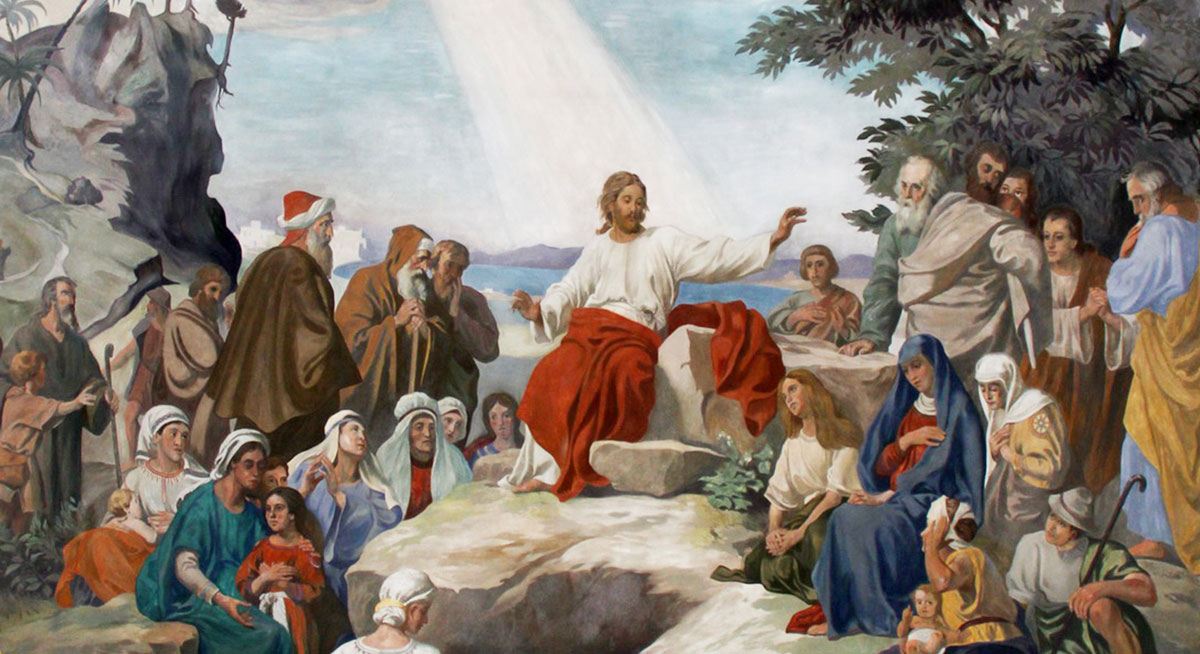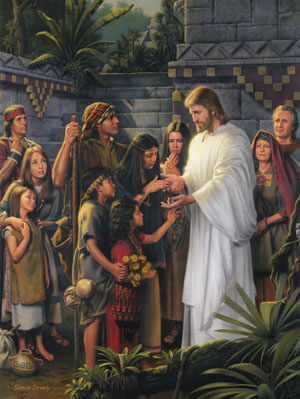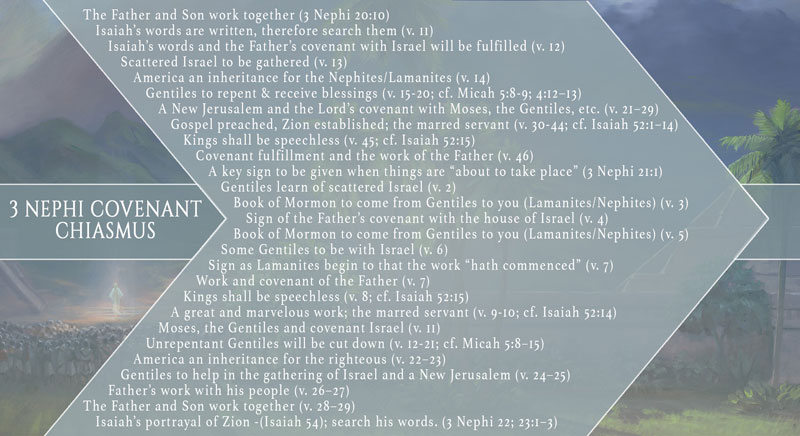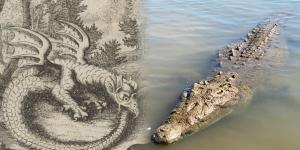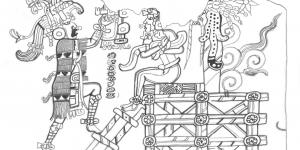You are here
Why Did Jesus Mix Together Micah and Isaiah?

3 Nephi 20:25
The Know
On His second day among the Nephites, reported in 3 Nephi 20:10–23:5, Jesus quoted extensively from Micah and Isaiah, so much so that exactly half of the verses in the speech come from these prophets.1 These quotations often make the sermon difficult to follow.2 Yet these quotations stress the importance of covenants, which was exactly the principle Christ was teaching in what Victor Ludlow has called “The Father’s Covenant People Sermon.”3
This assertion is borne out by the repetition of specific words and phrases.4 For example, in these two chapters alone, the word “covenant” appears 16 times, “the Father” appears 39 times, and “the people” appears 35 times, indicating that the discourse revolves emphatically around the Father’s covenant with his people, the house of Israel.5
Jesus began the speech by mentioning that part of God fulfilling his covenant with Israel would be that Israel would be gathered and the descendants of Lehi would receive their inheritance in the Americas (3 Nephi 20:12–14). Jesus quoted from Micah 5:8-9, and 4:12–13, to explain the destruction that the covenant people will bring upon the Gentiles who reject that covenant (in 3 Nephi 20:15–20).6 He emphasizes that establishing His people in the New World was one way in which God would fulfill His covenant with Abraham and Jacob. God would bless the whole world, including the Gentiles, through his covenant people (3 Nephi 20:21–29).
Christ used Isaiah 52:1–3, 6–15 in the same way. Christ said that when the people of the Old World accept Him and His new covenant, Christ will “give unto them Jerusalem for the land of their inheritance” (3 Nephi 20:31–33). Christ will bless them with the blessings of the covenant by freeing Jerusalem from slavery or “redeeming it.”7 Christ will do this by “making bare his holy arm,” or fighting, for Jerusalem, such that the entire earth will know that God has brought salvation to His people, living up to His end of the covenant (v. 34–35).8 Those who are not part of the covenant, who are metaphorically referred to as “the uncircumcised,” will not be able to enter Jerusalem (v. 36).9 Christ will fulfill His covenant to free the people from the symbolic slavery they have labored under, and Jehovah will be their king (vv. 37–40).10
His people will restore the temple, complete with its “vessels,” and the “covenant which the Father hath covenanted with his people [will] be fulfilled” (3 Nephi 20:41–46).11 The Gentiles will then become part of the covenant, allowing them to bring the gospel to the descendants of Lehi, thus fulfilling the covenant with them as well (3 Nephi 21:1–7). Christ quoted Isaiah 52 to emphasize the work His servant will do to bring the covenant to the Gentiles (3 Nephi 21:8, 10). And concluded by commenting on Micah 5:8–15, showing the devastation that would fall on those Gentiles if they reject the covenant (3 Nephi 21:12–22).12
Even the structure of the speech connects it to covenants. This speech, like many others in the Book of Mormon, is chiastic, and in chiasms, the center point is often the most important.13 The central point of this sermon is the sign of God’s covenant with His people, the coming forth of the Book of Mormon. This signifies that God’s covenant with His people is the main point of the speech. This structure and the centrality of covenants begins to make sense of the seemingly choppy use of Micah and Isaiah.
The chiasm is as follows:14
| A The Father and Son work together (3 Nephi 20:10) | |||||||||||||
| B Isaiah’s words are written, therefore search them (v. 11) | |||||||||||||
| C Isaiah’s words and the Father’s covenant with Israel will be fulfilled (v. 12) | |||||||||||||
| D Scattered Israel to be gathered (v. 13) | |||||||||||||
| E America an inheritance for the Nephites/Lamanites (v. 14) | |||||||||||||
| F Gentiles to repent & receive blessings (v. 15–20; cf. Micah 5:8-9; 4:12–13) | |||||||||||||
| G A New Jerusalem and the Lord’s covenant with Moses, the Gentiles, etc. (v. 21–29) | |||||||||||||
| H Gospel preached and Zion established; the marred servant (v. 30–44; cf. Isaiah 52:1–14) | |||||||||||||
| I Kings shall be speechless (v. 45; cf. Isaiah 52:15) | |||||||||||||
| J Covenant fulfillment and the work of the Father (v. 46) | |||||||||||||
| K A key sign to be given when things are “about to take place” (3 Nephi 21:1) | |||||||||||||
| L Gentiles learn of scattered Israel (v. 2) | |||||||||||||
| M These things in the Book of Mormon to come from Gentiles to you (Lamanites/Nephites) (v. 3) | |||||||||||||
| N Sign of the Father’s covenant with the house of Israel (v. 4) | |||||||||||||
| M’ These works in the Book of Mormon to come from Gentiles to you (Lamanites/Nephites) (v.5) | |||||||||||||
| L’ Some Gentiles to be with Israel (v. 6) | |||||||||||||
| K’ Sign as Lamanites begin to know that the work “hath commenced” (v. 7) | |||||||||||||
| J’ Work and covenant of the Father (v. 7) | |||||||||||||
| I’ Kings shall be speechless (v. 8; cf. Isaiah 52:15) | |||||||||||||
| H’ A great and marvelous work; the marred servant (v. 9–10; cf. Isaiah 52:14) | |||||||||||||
| G’ Moses, the Gentiles and covenant Israel (v. 11) | |||||||||||||
| F’ Unrepentant Gentiles will be cut down (v. 12–21; cf. Micah 5:8–15) | |||||||||||||
| E’ America an inheritance for the righteous (v. 22–23) | |||||||||||||
| D’ Gentiles to help in the gathering of Israel and a New Jerusalem (v. 24–25) | |||||||||||||
| C’ Father’s work with his people (v. 26–27) | |||||||||||||
| A’ The Father and Son work together (v. 28–29) | |||||||||||||
| B’ Isaiah’s portrayal of Zion (Isaiah 54); search his words. (3 Nephi 22; 23:1–3) | |||||||||||||
The Why
As Christ concluded this instructive speech, He spoke about something that applies directly to people living in the world today. He explained that if the Gentiles joined the covenant, they would assist in the gathering of Israel, allowing God’s covenant to be fulfilled (3 Nephi 21:22–29).15
In 3 Nephi 22:1–23:5, Christ then quoted Isaiah 54 to reassure His people of the everlasting nature of His covenant with them and to speak warmly of the many blessings that will be given to covenant keepers. He reminded them that “the mountains shall depart and the hills be removed, but my kindness shall not depart from thee, neither shall the covenant of my peace be removed” (3 Nephi 22:10).
For some, Christ’s covenants with His people in the Old Testament and Book of Mormon may seem buried in the remote past, with little application to people today. However, Christ reminded his people that His covenants are eternal, and that the Gentiles of the latter days would actively participate in those covenants.
3 Nephi 20–22 persuasively illustrates that covenants are central to God’s dealings with his people in all periods of time. Even after all that the Nephites had done, Christ reminded His people that He had never forgotten the covenants He made with them, and that He never would. The center point of Jesus’s words on this occasion speak of the coming forth of the Book of Mormon in these the latter days as a sign that God has again set his hand to honor and fulfill the covenants he made with his covenant people in past dispensations.
As Jesus introduced Himself to the people gathered at the temple in Bountiful, he said, “Behold, I am Jesus Christ, whom the prophets testified shall come into the world” (3 Nephi 11:10). He drew significantly and purposefully from the prophetic writings of Micah and Isaiah, Israelite prophets who had lived about a hundred years before the time of Lehi. Jesus used those prophecies to show the Nephites that some of these prophecies remained yet to be fulfilled. He expounded and contextualized these prophecies clearly and brilliantly. He assured these people that He, His Father, and his covenant people would work together to bring to pass the Father’s glorious work.
The Book of Mormon reminds all who read it of the reliability of God. The Nephites certainly knew that mortals fail.16 Governments come and go, people are sometimes “quick to do iniquity, and … slow to do good” (Helaman 12:4). But the righteous Nephites knew with assurance that they could always rely on Christ to keep His covenants with them, even when all else failed. Modern readers can confidently take the same solace from the Book of Mormon. No matter how long ago Christ made these covenants with His people, they still apply to people today. Christ always kept His covenants with the Nephites, and He will always keep His covenants with those of the new and everlasting covenant today.
Further Reading
Victor L. Ludlow, “The Father’s Covenant People Sermon: 3 Nephi 20:10–23:5,” in Third Nephi: An Incomparable Scripture, ed. Andrew C. Skinner and Gaye Strathearn (Salt Lake City and Provo. UT: Deseret Book and Neal A. Maxwell Institute for Religious Scholarship, 2012), 147–174.
Joseph Fielding McConkie, “The Doctrine of a Covenant People,” in The Book of Mormon: 3 Nephi 8 Through 30, This is My Gospel, eds. Monte S. Nyman and Charles D. Tate, Jr. (Provo, UT: Religious Studies Center, Brigham Young University, 1993), 357–377.
- 1. Victor L. Ludlow, “The Father’s Covenant People Sermon: 3 Nephi 20:10–23:5,” in Third Nephi: An Incomparable Scripture, ed. Andrew C. Skinner and Gaye Strathearn (Salt Lake City and Provo, UT: Deseret Book and Neal A. Maxwell Institute for Religious Scholarship, 2012), 148.
- 2. Part of the difficulty in understanding simply comes from being part of a modern, rather than an ancient, audience. Most members of an ancient audience listening to this speech would likely have understood blessings and curses associated with covenants. See, for example, Leviticus 26 and Deuteronomy 28.
- 3. Ludlow, “The Father’s Covenant People Sermon,” 147.
- 4. Specific words matter in Israelite literature, and the Book of Mormon is no exception. See Yairah Amit, Hidden Polemics in Biblical Narrative, trans. Jonathan Chipman, BibInt 25 (Leiden: Brill, 2000), 42.
- 5. Ludlow, “The Father’s Covenant People Sermon,” 149.
- 6. Francis I. Andersen and David Noel Freedman, Micah: A New Translation with Introduction and Commentary, Anchor Bible Commentary, Volume 24E (New York, NY: Doubleday, 2000), 487.
- 7. Klaus Baltzer, Deutero-Isaiah: A Commentary on Isaiah 40–55, Hermeneia—A Critical and Historical Commentary on the Bible, trans. M Kohl (Minneapolis, MN: Fortress Press, 2001), 384.
- 8. Baltzer, Deutero-Isaiah, 384.
- 9. Baltzer, Deutero-Isaiah, 371.
- 10. Joseph Blenkinsopp, Isaiah 40–55: A New Translation with Introduction and Commentary, Anchor Bible Commentary, Volume 40 (New York, NY: Doubleday, 2002), 343.
- 11. Baltzer, Deutero-Isaiah, 370.
- 12. Note that He includes some insertions here in 3 Nephi 21:14, 19-20, 22. For more on the themes in Micah see Delbert R. Hillers, Micah, Hermeneia—A Critical and Historical Commentary on the Bible (Minneapolis, MN: Fortress Press, 1984), 70–74.
- 13. Although common in Biblical and Ancient Near Eastern sources, chiasmus is also common in pre-Columbian America, and so would have been well understood by Christ’s audience. In both cases, the central point is the most important. See Allen J. Christenson, “Chiasmus in Mesoamerican Texts,” in Reexploring the Book of Mormon: A Decade of New Research, ed. John W. Welch (Salt Lake City and Provo, UT: Deseret Book and FARMS, 1992), 233–235; Allen J. Christenson, ed. and trans., Popol Vuh: The Mythic Sections—Tales of First Beginnings From the Ancient K’iche’-Maya, Ancient Texts and Mormon Studies 2 (Provo, UT: FARMS, 2000), 12–17; Allen J. Christenson, trans., Popol Vuh: The Sacred Book of the Maya (Norman, OK: University of Oklahoma Press, 2007), 46–47; Kerry Michael Hull, Verbal Art and Performance in Ch’orti’ and Maya Hieroglyphic Writing, (PhD dissertation, University of Texas at Austin, 2003), 175–178, 297–301, 480–481. For general information about chiasmus in the Book of Mormon, see Book of Mormon Central, “Why Is The Presence Of Chiasmus In The Book Of Mormon Significant? (Mosiah 5:10–12),” KnoWhy 166 (August 16, 2016).
- 14. Ludlow, “The Father’s Covenant People Sermon,” 166.
- 15. Not surprisingly, 3 Nephi 20:29 is very similar to Isaiah 52:12.
- 16. See Book of Mormon Central “How Did The Nephites Become Weak In Such A Short Time? (Helaman 4:25),” KnoWhy 175 (August 29, 2016).
KnoWhy Citation
Related KnoWhys
Subscribe
Get the latest updates on Book of Mormon topics and research for free

